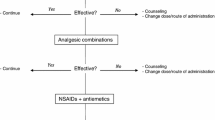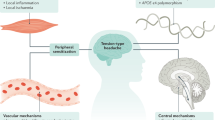Abstract
Behavioral and psychologic factors in tension-type headache are reviewed with reference to pathophysiology, comorbid psychiatric disorders, headache triggers, and behavioral treatment, including the efficacy of behavioral treatments, brief minimal contact administration of behavioral treatment, therapeutic mechanisms underlying the effectiveness of behavioral treatments, and the integration of drug and behavioral treatments. Anxiety or depression may contribute to central sensitization that underlies frequent tension-type headaches. Excessive analgesic use, comorbid psychiatric disorders, or persistent unaddressed headache triggers may limit the effectiveness of headache treatment. Available drug and behavioral treatments are effective for episodic tension-type headache, but are only moderately effective for chronic tension-type headaches. The combination of behavioral and preventive drug therapies may improve outcomes for patients with chronic tension-type headache.
Similar content being viewed by others
References and Recommended Reading
Olesen JC: Classification and diagnostic criteria for headache disorders, cranial neuralgias, and facial pain: Headache Classification Committee of the International Headache Society. Cephalalgia 1988, 8 (Suppl. 7).
Jensen R, Sandrini G: Symptomatology of chronic tensiontype headache. In The headaches edn 2. Edited by Olesen J, Tfelt-Hansen P, Welch KMA: Philadelphia: Lippincott Williams & Wilkins; 2000:627–634.
Schoenen J, Wang W: Tension-type headache. In Headache. Edited by Goadsby PJ, Silberstein SD: Woburn, MA: Butterworth-Heinemann; 1997:177–200.
Holroyd K, Stensland M, Lipchik G, et al.: Psychosocial correlates and impact of chronic tension-type headaches. Headache 2000, 40:3–16.
Bernstein R: Central sensitization and headache. In The Headaches edn 2. Edited by Olesen J, Tfelt-Hansen P, Welch KMA: Philadelphia: Lippincott Williams & Wilkins; 2000:125–136.
Olesen J, Schoenen J: Synthesis of tension-type headache mechanisms. In The Headaches, edn 2. Edited by Olesen J, Tfelt-Hansen P, Welch KMA: Philadelphia: Lippincott Williams & Wilkins; 2000:615–618.
Bendtsen L: Central sensitization in tension-type headachepossible pathophysiologic mechanisms. Cephalalgia 2000, 20:486–508. Reviews evidence of the role that central sensitization plays in tension-type hedache.
Bendtsen L, Ashina M: Sensitization of myofascial pain pathways in tension-type headache. In The Headaches, edn 2. Edited by Olesen J, Tfelt-Hansen P, Welch KMA: Philadelphia: Lippincott Williams & Wilkins; 2000:573–568.
Schoenen J: Exteroceptive suppression of temporalis muscle activity in patients with chronic headache and in normal volunteers: Methodology, clinical, and pathophysiologic relevance. Headache 1993, 33:3–17.
Lipchik GL, Holroyd KA, France CR, et al.: Central and peripheral mechanisms in chronic tension-type headache. Pain 1996, 64:467–475.
Lipchik GL, Holroyd KH, Talbot F, Greer M: Pericranial muscle tenderness and exteroceptive suppression of temporalis muscle activity: a blind study of chronic tension-type headache. Headache 1997, 37:368–376.
Lipchik GL, Holroyd KA, O’Donnell FO, et al.: Exteroceptive suppression periods and pericranial muscle tenderness in chronic tension-type headache: effects of psychopathology, chronicity, and disability. Cephalalgia 2000, 20:638–646.
Bendtsen L, Jensen R, Brennum J, et al.: Exteroceptive suppression of temporal muscle activity is normal in chronic tension-type headache and not related to actual headache state. Cephalalgia 1995, 16:251–256.
Langemark M, Olesen J: Pericranial tenderness in tension headache: a blind, controlled study. Cephalgia 1987, 7:249–255.
Jensen R, Rasmussen BK, Pedersen B, Olesen J: Muscle tenderness and pressure pain thresholds in headache: a population study. Pain 1993, 52:193–199.
Bendtsen L, Jensen R, Olesen J: Qualitatively altered nociception in chronic myofascial pain. Pain 1996, 65:259–264.
Ashina M: Nitric oxide synthase inhibitors for the treatment of chronic tension-type headache. Expert Opin Pharmacother 2002, 3:395–399.
Janke EA, Holroyd KA: Depression increases vulnerability to tension-type headaches following stress in a laboratory paradigm. Ann Behav Med 2002, 24:S024.
Merikangas KR, Stevens DE, Angst J: Headache and Personality: results of a community sample of young adults. J Psychiatry Res 1993, 27:187–196.
Merikangas KR: Psychopathology and headache syndromes in the community. Headache 1994, 34:S17-S26.
Guidetti V, Galli F, Fabrizi P, et al.: Headache and psychiatric comorbidity: Clinical aspects and outcome in an 8 year follow-up study. Cephalalgia 1998, 18:455–462.
Goncalves JA, Monteiro P: Psychiatric analysis of patients with tension-type headache. In Tension-Type Headache: Classification, Mechanisms, and Treatment. Edited by Olesen J, Schoenen J. Philadelphia: Lippinncot Williams & Wilkins; 1993:167–172.
Puca F, Genco S, Prudenzano MP: Psychiatric comorbidity and psychosocial stress in patients with tension-type headache from headache centers in Italy. Cephalalgia 1999, 19:159–164.
Diener HC: Headache associated with chronic use of substances. In The Headaches. Edited by Diener HC, Dahlof C. Philadelphia: Lippincott, Williams, & Wilkins; 2000:871–877.
Michultka DM, Blanchard EB, Appelbaum KA, et al.: The refractory headache patient: II: high medication consumption (analgesic rebound) headache. Beh Res Ther 1989, 27:411–420.
Coyne L, Sargent J, Segerson J, Obourn R: Relative potency scale for analgesic drugs: use of psychophysical procedures with clinical judgments. Headache 1976, 16:70–71.
Baumgartner C, Wesseley P, Bingol C, et al.: Long-term prognosis of analgesic withdrawal in patients with drug-induced headaches. Headache 1989, 29:510–514.
Holroyd KA: Assessment and psychological treatment of recurrent headache disorders. J Consult Clin Psychol 2002, in press. Reviews recent research on psychosocial aspects of headache and headache treatment.
Holroyd KA, Lipchik GL, Penzien DB: Behavioral management of recurrent headache disorders. In Wolff’s Headache and Other Headache Pain, edn 7th. Edited by Silberstein SD, Lipton RB, Dalessio DJ. New York: Oxford University Press; 2001:562–598.
Blanchard EB, Andrasik F: Management of Chronic Headaches: A Psychological Approach. Elmsford, NY: Pergamon Press; 1985.
McCrory D, Penzien D, Hasselblad V, Gray R: Behavioral and Physical Treatments for Tension-Type and Cervicogenic Headache. DesMoines, IA: Foundation for Chiropractic Education and Research; 2001.
Bernstein DA, Carlson CR: Progressive relaxation: abbreviated methods. In Principles and Practice of Stress Management. Edited by Lehrer P, Woolfolk RL. New York: The Guilford Press; 1993:53–85.
Schultz J, Luthe W: Autogenic Training: A Psychophysiologic Approach in Psychotherapy, vol 1. New York: Grune & Stratton; 1959.
Benson H: The Relaxation Response. New York: William Morrow; 1975.
Schwartz MS: Biofeedback: A practitioner’s guide. New York: Guilford Press; 1995.
Holroyd KA, Andrasik F: A cognitive-behavioral approach to recurrent tension and migraine headache. In Advances in Cognitive-Behavioral Research and Therapy, vol 1. Edited by Kendall PE. San Diego: Academic Press; 1982:276–320.
Lipchik GL, Holroyd KA, Nash JM: Cognitive-behavioral management of recurrent headache disorders: a minimal-therapist contact approach. In Psychological Approaches to Pain Management, edn 2. Edited by Turk DC, Gatchel RS. New York: Guilford Press; 2002, in press. This article describes cognitive-behavioral (stress-management) treatments for headache.
Teders SJ, Blanchard EB, Andrasik F, et al.: Relaxation training for tension headache: comparative efficacy and cost-effectiveness of a minimal therapist contact versus a therapist delivered procedure. Behav Ther 1984, 15:59–70.
Tobin DL, Holroyd KA, Baker A, et al.: Development and clinical trial of a minimal contact, cognitive-behavioral treatment for tension headache. Cogn Ther Res 1988, 12:325–339.
Holroyd KA, Nash JM, Pingel JD, et al.: A comparison of pharmacological (amitriptyline HCl) and nonpharmacologic (cognitive-behavioral) therapies for chronic tension headaches. J Consult Clin Psychol 1991, 59:387–393.
Haddock CK, Rowan AB, Andrasik F, et al.: Home-based behavioral treatments for chronic benign headache: a meta-analysis of controlled trials. Cephalalgia 1997, 17:113–118.
Rowan AB, Andrasik F: Efficacy and cost-effectiveness of minimal therapist contact treatments of chronic headache: a review. Behav Ther 1996, 27:207–234.
Blanchard EB, Appelbaum KA, Radnitz CL, et al.: The refractory headache patient-I: chronic, daily, high-intensity headache. Beh Res Ther 1989, 27:403–410.
Arena JG, Hannah SL, Bruno GM, Meador KJ: Electromyographic biofeedback training for tension headache in the elderly: a prospective study. Biofeed Self-Regul 1991, 35:187–195.
Mosley TH, Grotheus CA, Meeks WM: Treatment of tension headache in the elderly: a controlled evaluation of relaxation training and relaxation combined with cognitive-behavior therapy. J Clin Geropsychology 1995, 1:175–188.
Agency for Health Care Research and Quality evaluation of behavioral treatments for tension-type headache: Behavioral and physical treatments for migraine headache accessible at: http://www.clinpol.mc.duke.edu/pubs/Publications/publications. html#Technical
Bogaards MC, ter Kuile MM: Treatment of recurrent tension headache: a meta-analytic review. Clin J Pain 1994, 10:174–190.
Holroyd KA, Penzien DB: Client variables in the behavioral treatment of recurrent tension headache: a meta-analytic review. J Beh Med 1986, 9:515–536.
Blanchard EB, Andrasik F, Ahles TA, et al.: Migraine and tension headache: a meta-analytic review. Behav Ther 1980, 11:613–631.
Holroyd KA, Malinoski PT, Carlson BW: Patient characteristics and treatment adherence predict response to antidepressant medication and to cognitive-behavior therapy for chronic tension-type headache. Ann Behav Med 2002, 24:S050.
Mongini: Personality traits, depression, and migraine in women: a longitudinal study. Cephalagia 2002, in press.
Andrasik F, Holroyd KA: A test of specific and nonspecific effects in the biofeedback treatment of tension headache. J Consult Clin Psychol 1980, 48:575–586.
Holroyd KA, Penzien DB, Hursey KG, et al.: Change mechanisms in EMG biofeedback training: cognitive changes underlying improvements in tension headache. In Psychosocial Processes in Health: A Reader. Edited by Steptoe A, Wardle J; 1984. vol reprint.
Blanchard EB, Kim M, Hermann CU, Steffek BD: Preliminary results of the effects on headache relief of perception of success among tension headache patients receiving relaxation. Headache Quarterly 1993, 4:249–253.
Rokicki LA, Holroyd KA, France CR, et al.: Change mechanisms associated with combined relaxation/EMG biofeedback training for chronic tension headache. Appl Psychophysiol Biofeedback 1997, 22:21–41.
Holroyd KA, O’Donnell FJ, Stensland M, et al.: Management of chronic tension-type headache with tricyclic antidepressant medication, stress-management therapy, and their combination: a randomized, controlled trial. JAMA 2001, 285:2208–2215. Largest controlled trial evaluating behavioral treatment for chronic tension-type headache.
Reich BA, Gottesman M: Biofeedback and psychotherapy in the treatment of muscle contraction/tension-type headache. In Headache Diagnosis and Interdisciplinary Treatment. Edited by Tollison CD, Kunkel RS. Baltimore: Urban & Schwartzenberg; 1993:167–180.
Blau JN, Thavapalan M: Preventing migraine: a study of precipitating factors. Headache 1988, 28:481–483.
Radnitz CL: Food-triggered migraine: a critical review. Ann Behav Med 1990, 12:51–65.
Rasmussen BK: Migraine and tension-type headache in a general population: precipitating factors, female hormones, sleep pattern, and relation to lifestyle. Pain 1993, 53:65–72.
Robbins L: Precipitating factors in migraine: a retrospective review of 494 patients. Headache 1994, 34:214–216.
Author information
Authors and Affiliations
Rights and permissions
About this article
Cite this article
Holroyd, K.A. Behavioral and psychologic aspects of the pathophysiology and management of tension-type headache. Current Science Inc 6, 401–407 (2002). https://doi.org/10.1007/s11916-002-0083-9
Issue Date:
DOI: https://doi.org/10.1007/s11916-002-0083-9




